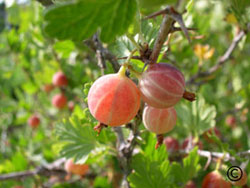What can I use gooseberries for?
Gooseberries are low-growing deciduous shrubs that reach three to six feet in height, have thorny stems and produce small fruit which is fresh-frozen or processed for use in jams and pies. They can be grown in home gardens and as landscaping features. Gooseberry fruits come in a variety of colors, including green, yellow, red or pink and may or may not have fine hairs. 
Where do gooseberries grow best?
Gooseberries are winter hardy in USDA Hardiness zones three to five. Native species are found in northern parts of North America, and will grow at elevations up to 10,000 feet, consequently, they perform better when they’re provided some shade and may defoliate if temperatures exceed 86 degrees Fahrenheit for an extended duration. The use of mulch will moderate soil temperature fluctuations in warmer environments
What pH should the soil be for gooseberries?
Optimum growing conditions include fertile, loamy soil that has good drainage and do best in a soil with a pH of 6.2 to 6.5, but will tolerate 5.5 to 7.0. At a higher pH, the fruit quantity may be limited, but the plants can still be used for landscaping. Gooseberries do best in cool temperatures with full sun.
Where should I not plant gooseberries?
Since Gooseberries are an alternate host for the white pine blister rust, avoid planting them with white pines. Gooseberries are susceptible to powdery mildew, so plant in a location where powdery mildew is less likely to thrive.
For more information, see the following Colorado State Extension fact sheet(s).
- Shade Tree Borers
- Currants, Gooseberries and Jostaberries
- The Living Soil
- Choosing a Soil Amendment
- Trees and Shrubs for Mountain Areas
- Mulches for Home Grounds
- Powdery Mildews



